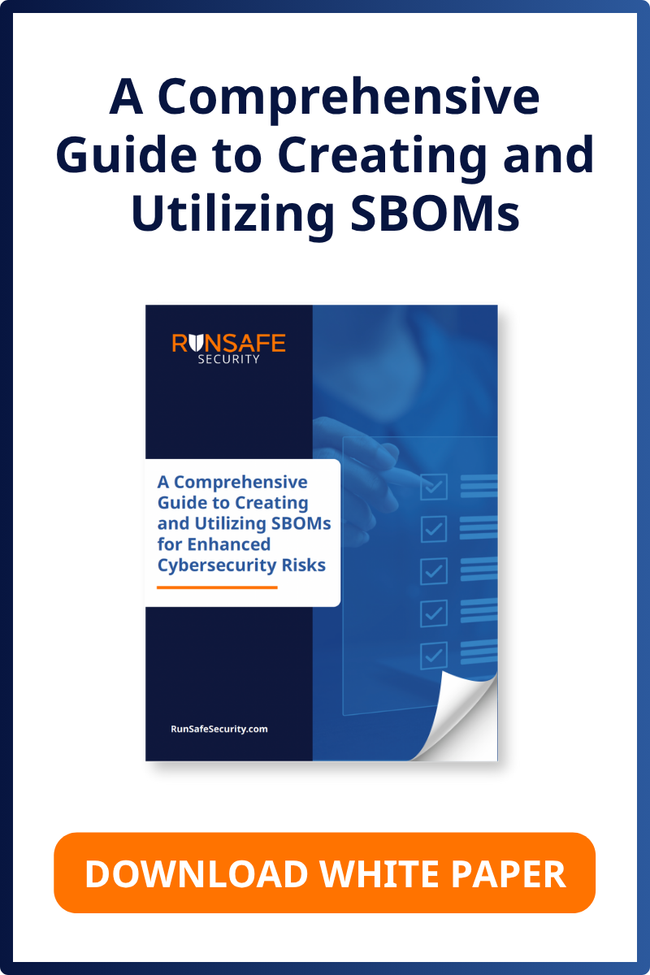Digital transformation is here to stay. The escalating frequency and sophistication of cyber threats have led to a pressing need for robust cybersecurity measures. Recognizing the urgency of addressing these challenges, the Cybersecurity and Infrastructure Security Agency (CISA) has championed the Secure by Design initiative [VIDEO]. This comprehensive approach seeks to fortify the foundation of digital systems by emphasizing security from the ground up. In this blog, we’ll explore the elements of Secure by Design, its significance, and how RunSafe Security contributes to securing product development practices.
Security Challenges and the Secure by Design Report:
The increasing frequency and sophistication of cyber threats have exposed vulnerabilities in digital systems, prompting the need for a proactive and holistic approach to cybersecurity. The Secure by Design initiative emerged in response to these challenges, aiming to transform the cybersecurity landscape by embedding security principles into the very fabric of digital systems.
The Secure by Design Report is a crucial document outlining the principles and strategies that form the foundation of this initiative. Released by CISA, the report delves into the importance of secure design practices and highlights their critical role in mitigating cyber risks.
What is Secure by Design?
Secure by Design, as defined by the CISA report, is an approach that integrates security considerations throughout the product development lifecycle. It emphasizes the proactive incorporation of security features and practices during the design phase, ensuring that cybersecurity is not an afterthought but an inherent aspect of the system.
The importance of Secure by Design cannot be overstated.
In an interconnected world where digital systems permeate every aspect of our lives, vulnerabilities in one area can have cascading effects. The Secure by Design approach seeks to address this by building resilient systems that can withstand cyber threats from the outset.
Manufacturers of digital products play a pivotal role in this paradigm shift. Failing to embrace Secure by Design principles can result in dire consequences, ranging from data breaches and financial losses to reputational damage. The urgency for product manufacturers to prioritize security in their design processes has never been greater.
What is Secure by Default?
Secure by Default is another critical aspect of CISA’s initiative. It entails configuring products and systems with the most secure settings as the default, minimizing the need for users to make manual adjustments to enhance security. This approach aims to reduce the risk of misconfigurations and ensure that security is not compromised due to user oversight.
Secure by Design and Secure by Default are interconnected concepts, but they address different product life cycle phases. Secure by Design is concerned with integrating security into the design and development stages, while Secure by Default focuses on ensuring that products are configured securely from the outset.
Together, these principles create a robust defense against a wide array of cyber threats.
How RunSafe Fulfills Secure by Design and Secure by Default:
RunSafe aligns closely with the principles of Secure by Design and Secure by Default, notably advocating for making products resilient against the most prevalent threats and vulnerabilities without requiring end-users to take additional actions.
RunSafe emphasizes proactive security measures in the early stages of product development with the manufacturers, integrating security into the design process. In doing this, RunSafe ensures that the products are inherently resistant to a wide range of cyber threats. This approach safeguards against known vulnerabilities and anticipates emerging risks, providing a dynamic defense mechanism.
RunSafe goes beyond conventional practices with code hardening to ensure the highest level of security protocols as the default. This minimizes the likelihood of recurring incidents after patches that could continue to compromise security.
RunSafe’s commitment to Secure by Default reflects a dedication to delivering solutions that prioritize critical infrastructure safety and security.
Recommendations for Software Manufacturers:
CISA’s Secure by Design initiative outlines three fundamental principles that software manufacturers should embrace to enhance the security posture of their products. Each principle serves as a roadmap for creating resilient and secure digital systems.
Principle 1: Own Security Outcomes
Take ownership of customer security outcomes and evolve products accordingly. The burden of security should not fall solely on the customer.
The report emphasizes that software manufacturers should integrate application hardening through processes and technologies that increase the difficulty for malicious actors attempting to compromise applications. Application hardening protocols and procedures are vital in enabling products to withstand attacks from intelligent malicious actors. Concepts such as hardening, product security, and resilience are closely intertwined with product quality, emphasizing the necessity for security to be seamlessly integrated rather than added as an afterthought.
Two ways that RunSafe demonstrates this principle are:
1. Responsibly using open source software: Beyond standard vetting, fostering code contributions back to dependencies, and helping sustain development and maintenance for critical components, RunSafe Code™ utilizes patented Moving Target Defense (MTD) techniques to fortify software during the design phase. This involves dynamically relocating where functions load into memory, creating a unique configuration for every software load and each deployed instance.
Since this is implemented in the design phase, no new software is introduced through patches, and no alteration of lines of code occurs. Consequently, there is no impact on system performance or functionality.
To provide additional transparency across the software supply chain, RunSafe offers an automated software bill of materials (SBOM) through its Gremlin product. Generated at compilation time, the comprehensive SBOM ensures developers have a clear snapshot of all software components at play.
2. Providing secure defaults for developers: Manufacturers should make the default route during software development secure by providing safe building blocks for developers. RunSafe solutions, applied to the build root like the way LYNX MOSA.ic is secured, become the default settings, ensuring protection against 70% of the most common vulnerabilities with no developer impact.
Principle 2: Transparency & Accountability
Embrace radical transparency and accountability. Software manufacturers ought to provide products that prioritize safety and security. This differentiation may involve the transparent sharing of insights gained from customer deployments, such as the widespread adoption of robust authentication mechanisms by default.
Additionally, manufacturers should exhibit a dedicated effort to maintain the completeness and accuracy of vulnerability advisories and associated Common Vulnerability and Exposure (CVE) records. However, caution is advised against viewing CVE counts solely as negative metrics, as these numbers can also signify a robust and active code analysis and testing community.
Runsafe’s solutions contribute to the recommended secure product development practices, particularly the advice to Embrace vulnerability transparency and Publish Software Bills of Materials (SBOMs). Due to RunSafe’s dedication to full compliance and proactive software immunization, it’s advantageous for manufacturers to publish vulnerabilities with the associated mitigations labeled as “protected by RunSafe.”
In addition, RunSafe’s automated SBOMs through Gremlin fulfill CISA’s recommendation to “build and maintain SBOMs for each product, request data from their suppliers, and make SBOMs available for downstream customers and users.” It’s important to consider varying types of SBOMs – build-time vs. binary-based – to determine which provides the most benefit to creating supply chain transparency.
One pro-security business practice that RunSafe supports is the publication of a memory-safety roadmap. Leveraging memory-safe languages enables manufacturers to make progress toward eliminating one of the largest classes of vulnerabilities.
Principle 3: Leadership
Build organizational structure and leadership to achieve these goals. While technical subject matter expertise is critical to product security, senior executives are the primary decision-makers for implementing organizational change. Executives need to prioritize security as a critical element of product development across the organization, and in partnership with customers.
RunSafe embodies the principles of Secure by Design and Secure by Default. Leading the charge and advocating for premium security measures, RunSafe stands as a reliable and trustworthy source of information for executives looking to better understand the best practices to implement Secure by Design practices.
After analyzing thousands of binaries and hundreds of thousands of functions using open-source software, RunSafe Security was able to show that there weren’t enough bits of code to misuse at a function-level, to create attacks that work on unprotected code.
Conclusion
CISA’s Secure by Design initiative presents a transformative approach to cybersecurity, emphasizing the integration of security into the very fabric of digital systems. Given the escalating cyber threats in today’s landscape, the urgency for product manufacturers to adopt these principles is evident.
The long-term benefits of embracing Secure by Design and Secure by Default are profound. As digital systems become increasingly integral to our critical infrastructure, a proactive and comprehensive security approach will not only safeguard against current threats but also future-proof products against emerging risks. The collaborative efforts of organizations like CISA and companies like RunSafe are instrumental in creating a resilient and secure digital ecosystem for generations to come.






